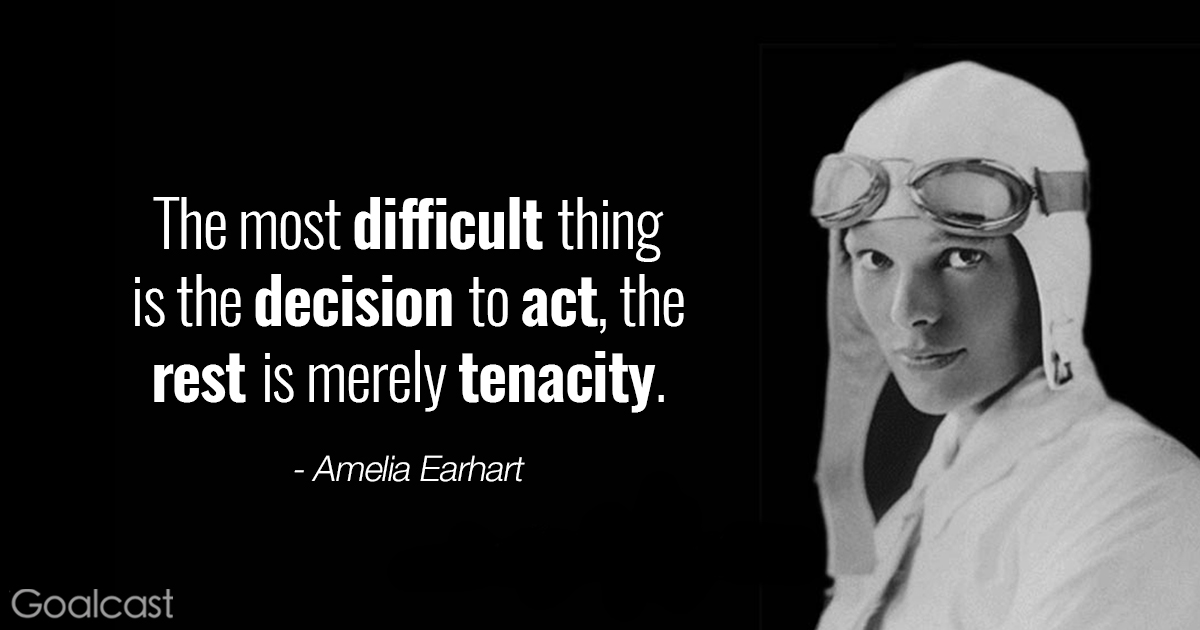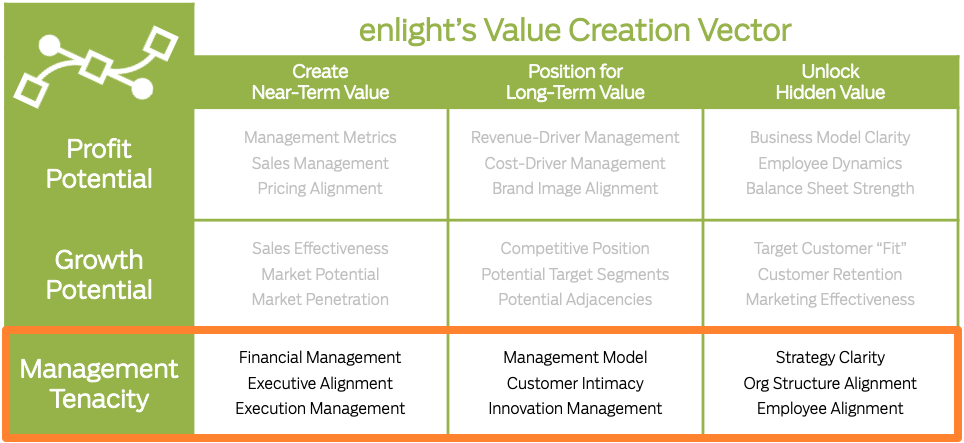
In our last post about the Value Creation Vector, we dug into the second lever, Growth Potential. Today we’re going to look at the third lever: Management Tenacity. Sadly, this lever is typically least interesting to management, even though it’s often the easiest way to generate value.

You may wonder why Management Tenacity is an easy way to generate value. The best I can tell you is that Management Tenacity captures how effectively and consistently your company and leadership do all the things they know they should do to be effective. It’s the business equivalent of diet and exercise. And, just like many of us eschew diet and exercise guidelines in favor of a magic pill to heal what ails us, many execs distract themselves with silver bullets – acquisitions, expansions, etc. – instead of rolling up their sleeves and getting to work.
As a refresher, here’s what I wrote about Management Tenacity in the original Value Creation Vector post:
It’s safe to say no one has ever hired us to improve management tenacity. And, that’s a crying shame. This is where the low-hanging fruit abounds. Always. A few small tweaks to how the management team works have lasting impacts on financial performance, longevity and morale – all with little or no financial risk.
When we assess a company’s management tenacity, we evaluate several factors that create Near-Term Value, Position the Company for Long-Term Value and Unlock Hidden Value.

Create Near-Term Value
As with the other two factors, we start by assessing Management Tenacity factors that can have a near-term impact on your company’s performance. The basic tenant remains true: small changes in these factors can have significant and immediate impacts on corporate performance.
The factors we consider are:
1. Financial Management – Does the management team monitor the right metrics to guide day-to-day decision making? We want to understand if the management team considers:
- Profitability by Customer, Product and Market
- Financial Statement Alignment
- Financial Metrics Alignment
- Visible and Transparent Financial Metrics
2. Executive Alignment – Is the executive team aligned on the foundational tenants of the business? We want to understand if the management team is aligned about:
- Strategy
- Metrics
- Investor Priorities
- Culture and Values
3. Execution Management – How effective is day-to-day management of the company? We want to understand if the management team has established:
- Comprehensive Operational and Strategic Metrics
- Visible and Transparent Operational & Strategic Metrics
- Clear Accountability
- Effective Internal Communication
Position for Long-Term Value
There are several management tenacity factors that can improve a company’s performance over the long-term. These factors – just like the long-term factors for Profit Potential and Growth Potential – improve the company’s proactivity, productivity and resiliency.
The factors we consider are:
1. Management Model – What is the executive team’s approach to enterprise management? Is the approached shared across the management team? How is it codified? We want to understand how the management team approaches:
- Employee Engagement
- Use of Data
- Collaboration
- Leadership Style
2. Customer Intimacy – Does the company really understand its customers? Is there an institutionalized means of maintaining understanding as customers change? We want to understand if the company:
- Objectively Understands Customer Needs
- Objectively Understands Influencers
- Understands Customer Business Models
- Understands Customers’ Pressures and Trends
3. Innovation Management – How does the executive team define and pursue innovation? We want to understand if the company has a robust innovation platform, including:
- Portfolio Approach
- Product/Service Innovation
- Process/Cost Innovation
- Innovation Process
Unlock Hidden Value
As with Profit Potential and Growth Potential, Management Tenacity factors that unlock hidden value are often overlooked and not necessarily intuitive. However, they make the company stronger and improve results.
The factors we consider are:
1. Strategy Clarity – Does your entire company understand the strategy and how it is operationalized? We want to remove hidden contradictions and/or confusion about the strategy that limit success:
- Clarity About Target Customers
- Clarity About Target Customer Benefits
- Clarity About Business Model
- Strategy is Broadly Understood
2. Org Structure Alignment – Is the company structured to effectively execute on the strategy? We want to eliminate hidden friction from org structure misalignment by ensuring:
- Key Roles Are Understood
- Staffing Alignment
- Reporting Relationships: Clear and Appropriate
- Operational Metric Alignment
3. Employee Alignment – Has the executive team equipped employees with the knowledge and tools they need to align their actions with the strategy? We want to remove hidden friction from day-to-day employee decisions that contradict each other or the strategy by ensuring:
- Individuals Understand Their Role
- Individuals Understand Others’ Roles
- Incentive Alignment
- Individuals Understand Connection to Customers
Congratulations! You made it through the three Value Creation Vector levers. Your profit potential is in order, your company is well-positioned to grow that profit, and management is aligned and committed to the work. Whether you seek to grow your company, improve its profitability or both, applying our Value Creation Vector will position your company to achieve its goals.


